David Nice writes: 2016 began by ringing in the new with concerts by the ever-astonishing National Youth Orchestra of Great Britain, and continued by ringing out the old-new with funeral bells on the news of Pierre Boulez’s death at the age of 90. Tributes began pouring in from all quarters, including a very pithy one from an old university friend, whom I remember in the early 1980s playing a very young Simon Rattle’s 1977 recording of The Rite of Spring with the NYO and regaling us with stories of how Boulez turned that interpretation on its head within weeks.
Other memorials revealed that Boulez had first conducted the orchestra in the work in a concert at the beginning of 1970, a partnership marked with a recording made under circumstances described below. It seemed like a good idea to contact friends and friends-of-friends from the (now) distinguished orchestral lists of both years to give their versions of what it was like to play under Boulez. Some were there at the start of the relationship, and others got the Rattle/Boulez double-whammy seven years later. And so, in chronological and then alphabetical order:
1969-70
Cathy Gough (trumpet, 1969-71)
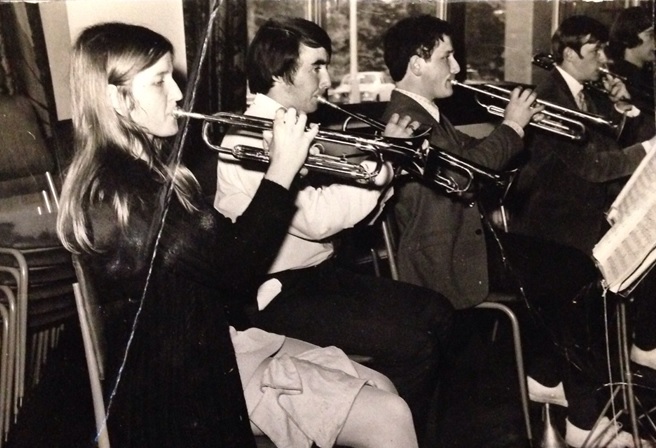
Pictured: Cathy Gough in a photograph taken by The Times in the summer of 1971 with NYO wind and brass rehearsing Stravinsky's Symphonies of Wind Instruments. First trumpet was John (Jock) Miller and first trombone Dudley Bright.
My first day with NYO was Boxing Day 1969. We were rehearsing The Rite of Spring and La Mer with Pierre Boulez and I was in awe of both conductor and orchestra. In an incredible silence Boulez immediately launched us into The Rite with no concession for our youth or lack of musical experience or knowledge.
I will never forget one rehearsal when we played straight throughThe Rite and sagged back exhausted but reasonably pleased with ourselves. Boulez just smiled, told us we could relax for five minutes and that we would then play the whole thing again - this time without counting: we should just feel the music, he said. On another occasion he was helping one of the percussionists with a cross rhythm and told her to watch his left hand. He then proceeded to conduct five in his right hand and seven in his left. We all laughed. He was enormously demanding but never unkind, always clear and concise in word, beat and movement but still suffused with great energy. All this was leavened by his wickedly dry humour.
The following year we performed more 20th century masterpieces with him at the Proms and Edinburgh International Festival: Stravinsky, Debussy, Webern, Bartók and Berg (Seven Early Songs and the Violin Concerto with Yehudi Menuhin). Superb, challenging programmes under the guidance of a master. What an introduction to such repertoire: astounding, ear-bending and sensuous, but always refined by his amazing ear and insistence on clarity of textures, especially demanding for such a large orchestra.
It was challenging and sometimes nerve wracking but principal players met the demands superbly. When it was tricky - I well remember repeating a particular passage in The Rite many times - he was always patient even if he could have had no conception of (my) rhythmic fallibility. For me and probably for many others who did not go on to play professionally, nothing could ever come close to the incredible musical experience and privilege of working with him amongst so many gifted young musicians. It was clear how much he enjoyed working with us and we felt his generosity of spirit and deed. After we performed The Rite in January 1970 in the Fairfield Halls, Croydon, he paid for a record of the performance to be made and sent to every young person playing (the very plain cover pictured further down). We have lost a giant and we were some of the lucky few to have felt his touch along the way.
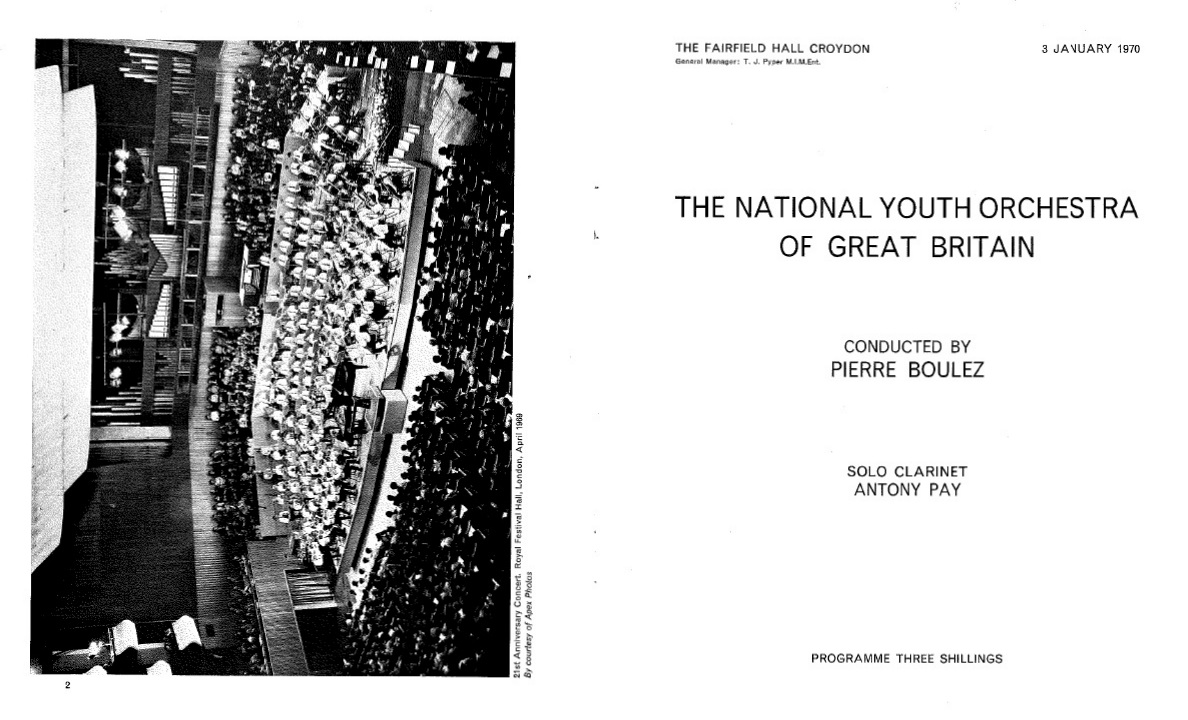 Marshall Marcus (violin, 1966-1973)
Marshall Marcus (violin, 1966-1973)
Saturday 27 December 1969. Pierre Boulez purposefully steps up onto the podium in the main hall of the John Whitgift School in Croydon for his first ever rehearsal with the National Youth Orchestra of Great Britain. His bearing is authoritative, imperious even. At this stage in his life - age 44 - he is well past the firebrand phase of his early career, yet to us there is still something a little forbidding about his presence (and not only because of the mythic reputation that has preceded him). In front of him are paraded, I don’t know, around 150 of the UK's finest instrumentalists aged 13-18.
Silence. I mean real silence, as only a concentrated orchestra can produce. He surveys the army of young musicians before him, taking in the disposition of the various instruments. The expectation is to be asked to begin with the opening bars of Stravinsky's The Rite of Spring, with its quiet and seductive bassoon solo as a gentle introduction to the somewhat terrifying rhythmic mayhem - or complexity as Boulez would probably have put it - to follow. But no, instead, with dry quiet brusque slightly rasping French intonation he utters two simple words, half information, half directive: "Danse Sacrale!". This, I learn later, is classic Boulez: plunging straight into one of the most difficult passages of a particularly challenging composition with an unknown, hardly tested group of players.
Here was a level of conducting skill that one could expect maybe once every 300 hundred years or soHis apparent assumption of our ability to succeed is the thing: not simply a compliment and a challenge, but also an injunction. There is no escape. He indicates to the bass clarinet the need to begin with the sequence of six falling notes that preface the pause that starts the great "Danse Sacrale" (actually six against seven including the rest, as he would probably have reminded us), and the player in question - one Andrew Marriner if memory serves correct - responds in exemplary fashion. From the outside of the fourth desk of first violins where I am sitting, I gasp inwardly. One of the most extraordinary musical journeys of my life has just begun.
By the time Boulez arrived to conduct the NYO in late 1969 he was almost exactly half way through his life. The Darmstadt years of exile were over, and he was within a few of years of coming home, following President Pompidou's famous invitation to him to become Director of IRCAM in Paris. For us players it was nothing less than a moment of revelation. I may have been a seasoned member of the NYO (almost 15 years old, I had attended my first course aged 11), but like the entire orchestra I had never experienced anything like this. For a change, it was indeed a brave new world.
Looking back to that project, the individual elements of his conducting expertise are not so difficult to describe: eschewing the requirement of lesser conducting mortals for a piece of wood to waive around, he had an absolutely incomparable ability to clearly show separate and different complex compound rhythms simultaneously with each of his hands, whilst having enough spare energy and attention for those piercing eyes to range freely around the entire membership of the Orchestra. And he managed all of this with apparent ease, a seemingly perfect grasp of the architecture of the scores, and - oh yes - surely the most acute hearing of any human being in the 20th century. But in the end, what we witnessed most on that first prescient day, was those two virtuoso fluid hands and the inexhaustible, limitless brain that directed them with such ease and such musical intelligence. Here was a level of conducting skill that one could expect maybe once every 300 hundred years or so.
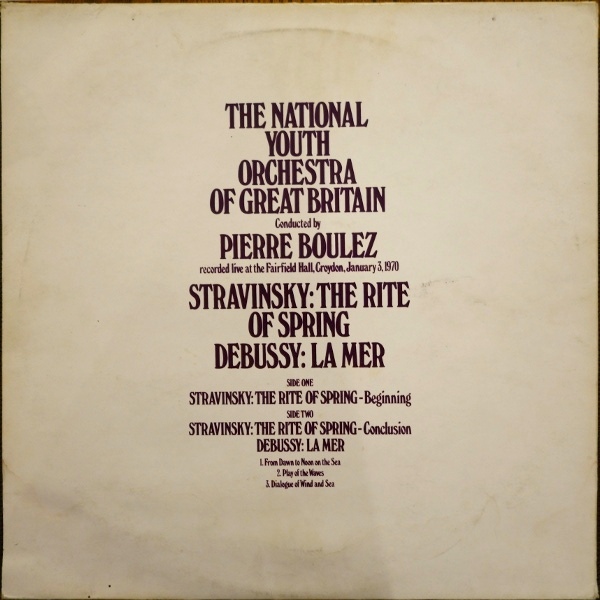 So there we are in Croydon, a bunch of late Sixties Brit teenagers happening upon a genius in the guise of a conductor who also happened to be one of the most important composers of the century. This was some opportunity. For the week or so that we were with him in 1969/70 (and many of us again in 1972), he was our catalyst, and I am sure that in the process he changed many of our lives. From Boulez I certainly learnt the importance of accuracy in all its modes (I am reminded of those words from Désormière, quoted by Boulez - "precision: a mark of aristocracy"). But more than that, he inspired aspiration; after Boulez 1969 there was for me simply no question of not setting out to try and succeed in that challenge, whatever it was, and whatever the difficulties involved.
So there we are in Croydon, a bunch of late Sixties Brit teenagers happening upon a genius in the guise of a conductor who also happened to be one of the most important composers of the century. This was some opportunity. For the week or so that we were with him in 1969/70 (and many of us again in 1972), he was our catalyst, and I am sure that in the process he changed many of our lives. From Boulez I certainly learnt the importance of accuracy in all its modes (I am reminded of those words from Désormière, quoted by Boulez - "precision: a mark of aristocracy"). But more than that, he inspired aspiration; after Boulez 1969 there was for me simply no question of not setting out to try and succeed in that challenge, whatever it was, and whatever the difficulties involved.
In later life I got to know Pierre Boulez in different ways, playing in performances of his and other works with the BBC Symphony Orchestra (a performance at the Edinburgh Festival of Rituel in the late Seventies had me carrying the pulse of the piece around for days after), and later programming his projects with Gillian Moore whilst Head of Music at Southbank Centre.
Of course with Boulez there was one big downside to that first encounter with him: working subsequently with any other conductor on a complicated score left a vacuum of security about which there was simply nothing to be done. As for the great man, as time went on he mellowed, his joke repertoire expanded (this is a man who dismissed his teacher Messiaen's massive Turangalila as "like Bernini in the suburbs"), his generosity, friendship and geniality became more visible, he enlarged his circle of collaborators to include the likes of Frank Zappa, and the wicked sense of humour increased its refusal to behave itself.
Yet he never lost that gimlet eye, or abandoned the stance that made him the undisputed generalissimo of modernism and the seminal musical figure of the second half of the 20th century. How lucky we were, those of us in the NYO on that day in 1969. Accident (as I would see it) allowed us to brush up against greatness, and as we mourn his passing and celebrate his life, I still feel the brush marks today because they are a drive that has, quite simply, never left me. Long live the memory of 1969. Long live the memory of Pierre.
Next page: The Rite of 1977: Ruth Addinall, Simons Bell, Channing and Morris and Peter Tanfield on Rattle followed by Boulez1977
Ruth Addinall (viola, 1975-7)
We made the recording with Rattle, an astonishing experience, and then Boulez took over for a performance, among others, in the Théâtre des Champs-Élysées, where The Rite of Spring was first performed. I have such vivid memories of the concert as we also played Bartók’s Music for Strings, Percussion and Celesta and the Berg Violin Concerto with Perlman. So lucky! When we came back for a final performance in the Festival Hall, Rattle was there and leapt up at the end with a huge "Bravo".
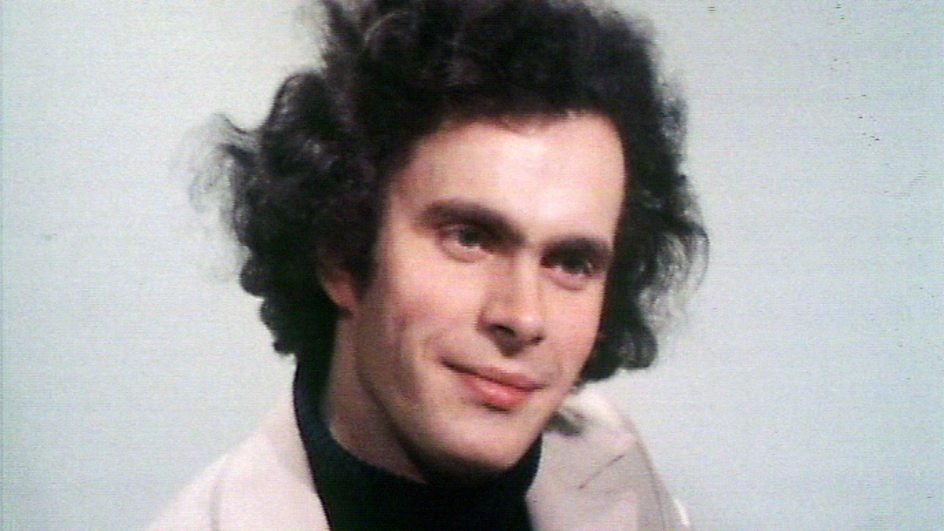 I remember that Boulez was very, very clear and incisive; both clinical and sensual - so very French! I fell in love with him, as did my desk partner Angela Swanson, now with the City of Birmingham Symphony Orchestra. I remember her using the 6B pencil that was an obligatory NYO requirement, to scribble Rattle hair (pictured above in a 1976 BBC interview) all the way round the page with the 11/4 bar. I think Boulez made some immediate structural changes to Rattle's version and he could (scarily) hear every note everyone was playing. I remember him beating the last page in three like a manic waltz – is that possible? Maybe he just talked to us about it. Rattle presumably recognised the improvements at the Festival Hall - he was after all not much older than the members of the orchestra at the time.
I remember that Boulez was very, very clear and incisive; both clinical and sensual - so very French! I fell in love with him, as did my desk partner Angela Swanson, now with the City of Birmingham Symphony Orchestra. I remember her using the 6B pencil that was an obligatory NYO requirement, to scribble Rattle hair (pictured above in a 1976 BBC interview) all the way round the page with the 11/4 bar. I think Boulez made some immediate structural changes to Rattle's version and he could (scarily) hear every note everyone was playing. I remember him beating the last page in three like a manic waltz – is that possible? Maybe he just talked to us about it. Rattle presumably recognised the improvements at the Festival Hall - he was after all not much older than the members of the orchestra at the time.
Simon Bell (piccolo in The Rite, flute, 1974-1978)
In 1976-7 I was a 15-year-old flautist in my third year with the NYO. As the number two in the section I was chosen to take the piccolo part in The Rite of Spring – a very tricky and, as always for the piccolo, exposed part. I was terrified.
 The Simon Rattle recording (pictured left) which took part over two days, was helped by the fact of Simon’s youth. He can’t have been much over 21, had recently won the John Player conducting prize in those far-off days when fag companies could sponsor such things and had himself been in the orchestra a few short years before as a percussionist. His interpretation was as I recall fast, furious, loud and full of the impetuosity of youth. Looking back this must have been an odd experience for him – but relative to dealing with the grown-up orchestras which he would then have been starting to work with, comparatively relaxing.
The Simon Rattle recording (pictured left) which took part over two days, was helped by the fact of Simon’s youth. He can’t have been much over 21, had recently won the John Player conducting prize in those far-off days when fag companies could sponsor such things and had himself been in the orchestra a few short years before as a percussionist. His interpretation was as I recall fast, furious, loud and full of the impetuosity of youth. Looking back this must have been an odd experience for him – but relative to dealing with the grown-up orchestras which he would then have been starting to work with, comparatively relaxing.
The recording in the can, it was time for a change of conductor for the concert tour. Enter maestro Boulez. Boulez, you ask, why on earth would he be frittering his talent on a youth orchestra? Three reasons, I would hazard. First, the NYO were damn good. Under the redoubtable Dame Ivey Dickson, the orchestra was unanimously considered the best of its kind in the world. Second, the NYO were unconstrained by economies of scale: the orchestra could field upwards of 150 players. For a conductor that had always lusted for three contrabassoons, then, this was your band. Thirdly, and most crucially, the rehearsal time given over for a single programme was a full week, an unheard-of luxury in the time-constrained world of the modern symphony orchestra: musical catnip for the punctilious conductor.
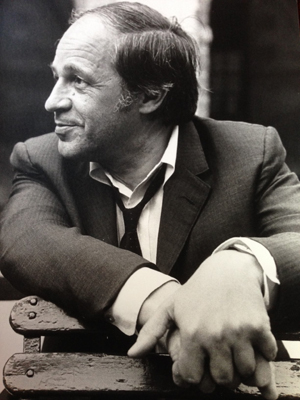 Boulez (pictured right) proceeded to pull apart the Rattle interpretation and make the work his own. Boulez’s version was slow to the point of languor and full of dynamic chiaroscuro. I recall his predilection in rehearsal for singling out unusual instrumental combinations to hear what he needed to calibrate and create something “in his own Rite”. There is a particularly difficult piccolo passage about 10 minutes in which, mercifully, you can just about fudge in the bombast of a full orchestra at fff. Boulez in rehearsal asked for this passage to be pulled out with just piccolo, trombones, bass and harp in combination. Terror! Exposure in front of the whole band! We had to repeat it around five times – each time with a slightly different combination of instruments until finally he asked for the piccolo solo. I got away with it – in fact I earned a rare "bien joué". I can’t believe it was note perfect.
Boulez (pictured right) proceeded to pull apart the Rattle interpretation and make the work his own. Boulez’s version was slow to the point of languor and full of dynamic chiaroscuro. I recall his predilection in rehearsal for singling out unusual instrumental combinations to hear what he needed to calibrate and create something “in his own Rite”. There is a particularly difficult piccolo passage about 10 minutes in which, mercifully, you can just about fudge in the bombast of a full orchestra at fff. Boulez in rehearsal asked for this passage to be pulled out with just piccolo, trombones, bass and harp in combination. Terror! Exposure in front of the whole band! We had to repeat it around five times – each time with a slightly different combination of instruments until finally he asked for the piccolo solo. I got away with it – in fact I earned a rare "bien joué". I can’t believe it was note perfect.
I recall the 50-year-old Boulez as dry, witty and making no concessions to youth. He treated us as he would an adult orchestra and we adored him for it.
It was a tradition to give our conductors a gift from the orchestra: a gift of their own choosing. He selected the fattest and most lavish monograph on the Swiss painter Paul Klee. As he received it in front of 200 worshipful adolescents, did I detect a tear in the eye of the austere Boulez? Perhaps.
Simon Channing (alto flute in The Rite, then principal flute, 1976-9)
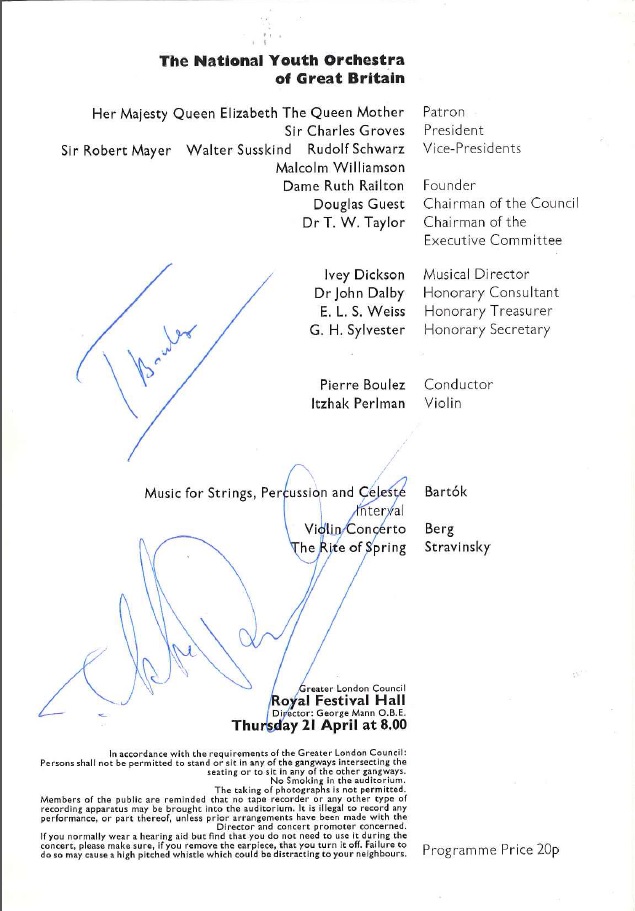 What I remember most from the Boulez course was the difference between his reputation - for being fearsome - and the reality, which was that he was incredibly generous and understanding, whilst still expecting the highest standards from us. He always seemed to have so much in reserve in terms of his understanding and command of all the forces (which, this being the NYO, were huge). He had a lovely, rather gentle, sense of humour. We loved him. I was incredibly fortunate to have sung as a chorister in the recording of The Dream of Gerontius with Britten conducting. And my impression of the two was of a similar innate authority which allowed them to be at peace with themselves - or to appear to be!
What I remember most from the Boulez course was the difference between his reputation - for being fearsome - and the reality, which was that he was incredibly generous and understanding, whilst still expecting the highest standards from us. He always seemed to have so much in reserve in terms of his understanding and command of all the forces (which, this being the NYO, were huge). He had a lovely, rather gentle, sense of humour. We loved him. I was incredibly fortunate to have sung as a chorister in the recording of The Dream of Gerontius with Britten conducting. And my impression of the two was of a similar innate authority which allowed them to be at peace with themselves - or to appear to be!
I remember too the wonderful chemistry between Boulez and Perlman who played the Berg Violin Concerto in the same concert - again, some very relaxed humour between them (pictured: programme signed by Boulez and Perlman). I still can’t believe we played first at the Royal Festival Hall and then at the Théâtre des Champs-Élysées.
Simon Morris (cello, 1976-7)
I grew up in Cornwall and most of my musical experiences had been there. So to be transported to the Théâtre des Champs-Élysées with Boulez conducting this massive orchestra that had been trained note by note was a life changing experience.
Boulez himself treated the young players very much as professionals with no hint of being patronising. He was inspirational. Bartók's Music for Strings, Percussion and Celesta divides into two orchestras. At one point Boulez gave a very dramatic gesture to the first orchestra - nothing happened. It was the second orchestra that played that passage. I still remember his wry smile. Good to know that even the best can catch themselves out sometimes.
Peter Tanfield (violin, 1974-8)
On a very green, over-enthusiastic and highly susceptible 16-year-old Pierre Boulez made an unforgettable and profound impression.
His arrival at the first rehearsal was much-anticipated, and we were not disappointed - if not in ways we had expected. He walked in wearing a pale grey suit with a pale blue polo-necked sweater, his jacket over one shoulder and no score or even baton, simply smiling with what seemed a calm and kindly interest. He did not overwhelm with charisma - although he had plenty of that - for he was too straightforward and matter-of-fact, nor with brilliance for - brilliant as he was - nothing was done for show. He just got on with it with extraordinary effectiveness, knowing exactly what he needed from the players, with complete objectivity, economy and lack of fuss.
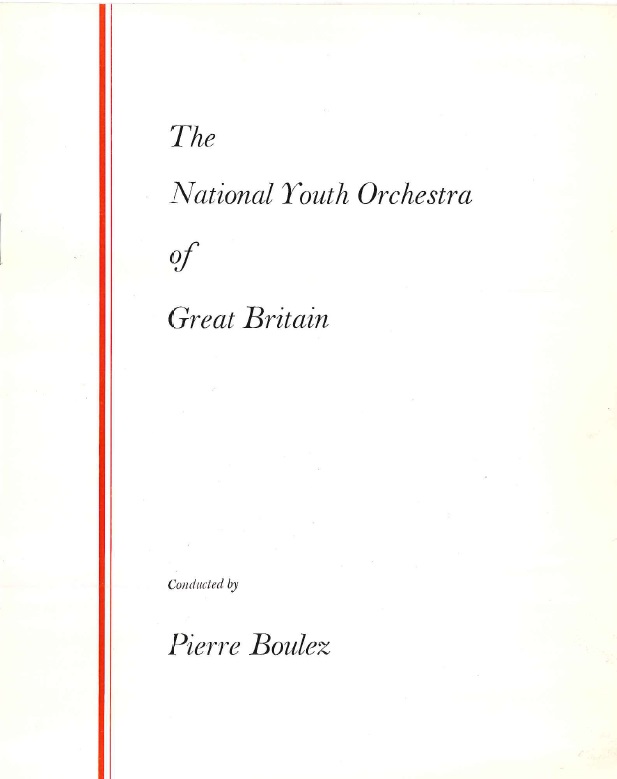 He had the ears of a bat, it seemed, hearing every tiny thing, with an exceptional mind for understanding the composer's intentions and a phenomenal overview of the works, their rehearsal and performance. His legendary sense of time was demonstrated in Bartók's specific durations of movements in his Music for Strings, Percussion and Celesta, timings to which Boulez consciously did not adhere exactly. He was as specific as Bartók about his durations, however, and - teenagers as we were - we could not resist putting them to the test with a stop-watch. We were not disappointed - Boulez's announced durations never varied, needless to say, nor did the music ever lose its life or excitement regardless. Every rehearsal - in addition to performances - was conducted without any reference to a score, even down to bar numbers and rehearsal figures; although perhaps this is a teenage memory exaggerated by the distance of time! He achieved wonderful sounds from the orchestra with extraordinary clarity - yet seemingly not by orthodox or expected means.
He had the ears of a bat, it seemed, hearing every tiny thing, with an exceptional mind for understanding the composer's intentions and a phenomenal overview of the works, their rehearsal and performance. His legendary sense of time was demonstrated in Bartók's specific durations of movements in his Music for Strings, Percussion and Celesta, timings to which Boulez consciously did not adhere exactly. He was as specific as Bartók about his durations, however, and - teenagers as we were - we could not resist putting them to the test with a stop-watch. We were not disappointed - Boulez's announced durations never varied, needless to say, nor did the music ever lose its life or excitement regardless. Every rehearsal - in addition to performances - was conducted without any reference to a score, even down to bar numbers and rehearsal figures; although perhaps this is a teenage memory exaggerated by the distance of time! He achieved wonderful sounds from the orchestra with extraordinary clarity - yet seemingly not by orthodox or expected means.
I never had the honour or pleasure of working with him again, unfortunately, but that NYO experience has remained with me undimmed and untarnished for almost 40 years; a precious memory indeed.

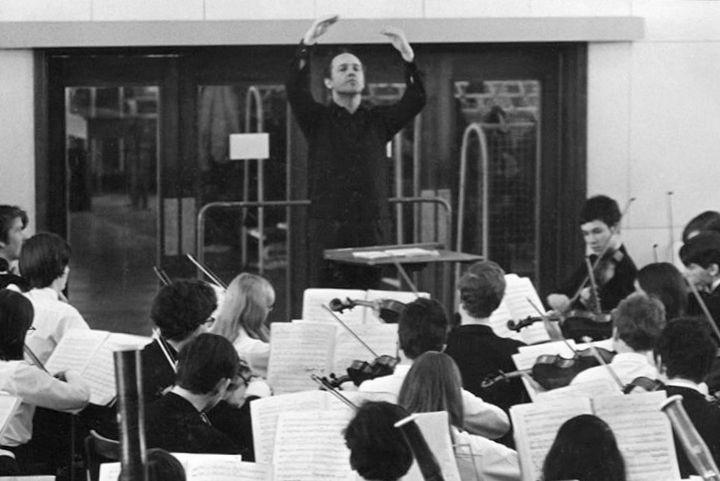





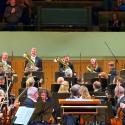
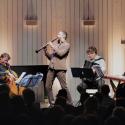






Add comment